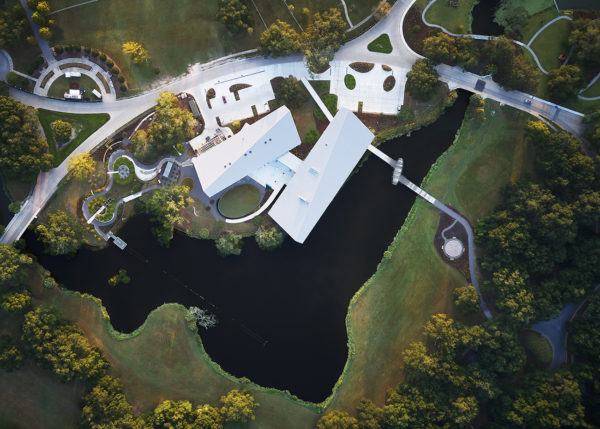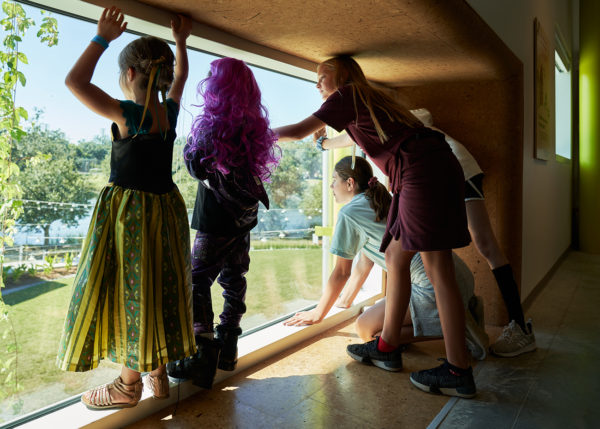Date Posted: 04.21.2020
After Hurricane Katrina in 2005, the Louisiana Children’s Museum (LCM) re-envisioned its mission to holistically address the health of children, many of whom had been traumatized by the storm. The health and well-being benefits of intentionally connecting children with nature led the museum to relocate from an indoor-focused experience in New Orleans’ Warehouse District to a new campus encircling a lagoon in the 1,300-acre City Park, home to the world’s largest collection of mature live oaks (some predating 1492). In addition, LCM forged partnerships with literacy, parenting, early childhood research and environmental education institutions to create a holistic and supportive environment for families. It is a groundbreaking and transformative model for children’s museums.
“The goal was to think holistically about how we design a building, grounds, exhibits, programs, partnerships and family learning experiences—all to advance goals of sustainability and stewardship for our community,” says LCM CEO Julia Bland. “This integrated planning approach has taken us on an amazing journey and will ultimately give our youngest citizens and their families a broad variety of experiences that will help build a much more resilient community—while having a lot of fun together.”
Connecting people with place
The visitor experience is designed to connect people with nature from their arrival—moving through groves of live oaks, across water, onto the large ‘lagoon porch,’ through the building and into a courtyard and sensory gardens. Two linked buildings are carefully sited to preserve existing live oaks, provide shaded prospect to the adjacent lagoon and define open areas for environmental education and play. This is a place designed to be responsive to the unique characteristics of this site and community.
The design team reached out to artist Fujiko Nakaya in Tokyo for the design of a cloud sculpture (shown above), after seeing her installation at the Tate Modern, which was busy with children on a cool and cloudy spring day. At LCM the periodic mist envelopes people on the boardwalk across the lagoon, instantly and viscerally creating a magical and inviting space for children, and an immersive water experience.
The ‘lagoon porch’ is a modern celebration of the great porticos and colonnades of New Orleans architecture. A plane of perforated louvers casts shadows on the arrival deck, reduces solar heat gain, and allows queuing, playing and eating in a space that overlooks the lagoon. The porch, store and café are open to the public and are an extension of public space in City Park. The generous proportions of the porch and the light colors of the building create a civic presence in response to the multiple pavilions found throughout the Park.
Sustainability strategies at LCM start with the site design and bioclimatic response of the building. Heavily fritted glazing at the “Julia Street” connector is designed for thermal shading and to reduce bird strikes on site. Cooling systems utilize chilled slabs and humidity reducing dessicant systems to reduce power use by 25 percent. The critical infrastructure of the building chiller and transformers are elevated for resilience.

Details INSPIRED BY NEW ORLEANS
Integrated into the museum experience are locally made products and experiences designed to prompt conversations about place. Mardi Gras beads, originally made from glass, are referenced by local artisan Mitchell Gaudet within interactive glass spheres at the entry railing that are inscribed with donor names (shown above). The blue glass entry vestibule, “Vesti-blue,” elicits memories of the distinctive blue doors of the museum’s previous home in the Warehouse District. At the reception desk, reclaimed sinker cypress brings texture and Louisiana natural history to the welcome experience.
As CEO Julia Bland says, “There are a million fingerprints from our community. It is fun and surprising everywhere you turn.”
Diverse new exhibits, designed by Gyroscope, include a life-sized interactive chess board sharing New Orleans history and the Mighty Mississippi exhibit, a giant water play table which follows the river’s journey from its headwaters in Minnesota, through Dubuque and Memphis, all the way to the Port of New Orleans and Gulf of Mexico. Reinforcing connections between indoor and outdoor play experiences, Mithun’s integrated design team extended these water experiences to the outdoors with a child-operable sluice gate that releases water flow into a shallow scrim and ends where kids can jump between “hummocks” immersed in the surroundings of freshwater marsh plantings. Water and play are celebrated in circular details like vine hummocks in the event plaza, steel drums, scribed water-drop patterns in the concrete floor, “firefly light” spherical glass pendants, and perforated metal stair rails and fritted glass that cast round shadows.

CELEBRATING LOUISIANA LANDSCAPES
The landscape design concept integrates the magic of child-centered play with simple expressions of local landscapes—the oaks, the hummocks and the hollows. Hummocks and hollows are shallow rises and depressions of the delta landscape where vegetation has built up and only a few inches of grade change supports a whole new ecosystem. The hummocks and hollows concept unfolds in multiple ways across scales—as small, medium and large program and outdoor exhibit areas create play experiences and build healthy habitat.
Mature live oaks, part of City Park’s carefully managed collection, imbue the site with history and grace. The building and arrival sequence was carefully coordinated with the design team and City Park arborist to protect existing live oaks and create powerful visual relationships with each of the distinctive oak trees from both inside and outside. One tree was removed and 26 new trees were planted to ensure the long-term health of the collection.
The planting design seeks to immerse visitors in environments that celebrate the variety of plantings at the water’s edge, the freshwater to brackish marsh, the bioretention areas that filter roof and parking lot runoff, and traditional plants found in New Orleans gardens. Along the shoreline and bioislands, adaptable tall marsh grasses like Bullrush, March Hay, Iris and Soft Rush transition to broadleaf marsh plants like Pickerelweed and Bulltongue, creating rich new habitat to birds, insects and reptiles. As a port city more than 300 years old, New Orleans is a place where botanic specimens were imported from all over the world, slowly becoming established in the city’s storied gardens. At LCM, an upland strolling sensory garden highlights local garden favorites such as butterfly ginger, jasmine, gardenia and azalea alongside newer species like Cherokee sedge, switchgrass, echinacea and salvia.
At the edible garden children can follow the growth of their food from seedling to harvest, reinforcing food exhibits inside the museum. Modeled after Alice Waters’ edible schoolyard program, children can make food at the sink and counter with vegetables they harvest. Education program leaders use the tactile landscape systems to help children interpret the site design to learn about larger environmental issues relevant to today’s world like coastal shoreline loss, local food production and water quality.

THE MAGIC OF CHILD-CENTERED PLAY
The Reggio Emilia child development philosophy—a child-centered approach that emphasizes multi-sensory nature play—guided the integrated site and building design. By creating environments that empower children to make their own choices, provide multi-sensory experiences, and enable and reflect children’s work and ideas, the museum encourages children and families to engage more deeply.
As a result, staff have noted that interaction across multi-generational families has increased. Children remain engaged longer in the experiences. These are the relationship-based hallmarks of success in holistic, child-centered design.
The building and landscape incorporate diverse child-scaled spaces like 12 “kindows” (small-scale bay windows that invite children to climb in and peer out across the site), two outdoor kindows where children can look from the edible garden to the hummock hop, as well as a child-sized entry door and dining banquettes in the Acorn café. Throughout the campus, children are invited to engage with each other and the natural world through play and multi-sensory expression—the simple, natural phenomenon of shadow play, listening to birds songs, orchestrating water flow, cooling in gentle mist, hiding (and seeking) in the cloud grasses, building nests together, working together to reel the floating classroom across the lagoon, crawling through the burrowing tunnel, and spotting sunning turtles and resting egrets.
IMMEDIATE AND LASTING IMPACTS
The project’s positive impacts are evident within site ecology, museum attendance and government policy.
When Mithun started this project in 2009 the Greater New Orleans Urban Water Plan, led by Waggonner & Ball, was emerging as a new green infrastructure paradigm for addressing flooding, subsidence and wasted water assets in the region. The design team embraced the resiliency opportunities outlined in the Plan and designed the building to sit five feet above grade for flooding and for the site to intentionally hold three feet of flood water—helping to reduce regularly-occurring flooding in neighborhoods like Treme and the French Quarter that share the same drainage system. By 2015 the City adopted the Water Plan and began incorporating projects. LCM, as part of a suite of projects, helped the City win a $141 million grant through the National Disaster Resilience Competition.
Upon its opening in late August 2019, the museum was quickly embraced as a vibrant “third place” for kids and families. In the first 100 days the museum welcomed more than 60,000 guests from 44 states, the District of Columbia and other countries. Memberships have quadrupled and expanded across 30 states. Local residents come on average every three weeks, with some regulars visiting over 40 times in the first 100 days! Louisiana citizens from more than 100 cities and towns across the state have come to play—a reinforcing metric for tax-payer investment since the State was a primary financial supporter.
The museum has inspired new investments in childhood education in New Orleans and statewide, an exciting change from Louisiana’s historical ranking among the lowest in national childhood development benchmarks. The New Orleans Mayor has allocated $3 million dollars in the operating budget for quality childcare support. In the first comments of his acceptance speech that November, re-elected Governor John Bel Edward committed to increased support for early childhood development. And a recent regional economic group survey identified early childhood development as the top priority within the region.
Continued momentum is anticipated. The State Department of Education initiated discussions with LCM about two meaningful possibilities: a water management curriculum tied to the new science curriculum being shared by four states, and an early learning / school readiness initiative.